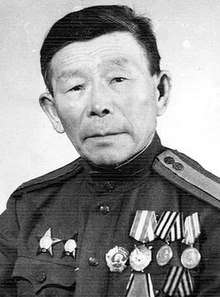Semyon Nomokonov
Semyon Danilovich Nomokonov (12 August 1900 – 12 June[1] or 15 July[2] 1973) was a Soviet sniper during World War II, credited with 367 kills, recorded in his sniper log.[1][lower-alpha 1] An ethnic Hamnigan Evenk,[lower-alpha 2] Nomokonov was among the indigenous peoples of Russia who fought in the war. He received the nickname Taiga Shaman from the enemies.[1][3]
Semyon Nomokonov | |
|---|---|
 | |
| Native name | Семён Данилович Номоконов |
| Nickname(s) | Taiga Shaman |
| Born | 12 August 1900 Delyun, Trans-Baikal Territory, Russian Empire |
| Died | 12 or 15 June 1973 Zugalai, Mogoytuysky District, Zabaykalsky Krai, USSR |
| Allegiance | |
| Years of service | 1941–1945 |
| Rank | Sergeant |
| Unit | 221st Infantry Division |
| Awards | Order of Lenin |
Nomokonov was awarded two Orders of the Red Star, Order of the Red Banner, Order of Lenin and medals.[2]
Early life
Nomokonov was born in the settlement of Delyun in Zabaykalsky Krai,[2] Russia (then Russian Empire), in a poor family of hunters,[1] and from childhood lived in taiga.[1] Nomokonov took the rifle for the first time at the age of seven.[3] He hunted sable, Manchurian wapiti and elk,[3] and was nicknamed Eye of the Kite.[2] Nomokonov was baptized at the age of 15 and received the name Semyon.[2] In 1928 Nomokonov moved to the settlement of Nizhny Stan in the Russian Shilkinsky District.[2] He continued hunting and carpentered.
War
Nomokonov started his military service in August 1941,[2] initially in a subsistence farm of a regiment.[1] Then he made crutches for the wounded.[1] Nomokonov became a sniper by chance. In the fall of 1941 he was evacuating one of the wounded, when he noticed a German, aiming at him.[1] Nomokonov killed him with his own rifle.[1] According to another version, in October 1941 Nomokonov received a rifle and decided to test it.[3] To avoid wasting the rounds, Nomokonov tested the rifle on a German, who was moving along the wooded lake shore, bending down.[3] After that Nomokonov was transferred to a sniper platoon.[1] He started to shoot from a Mosin–Nagant rifle without a telescopic sight.[1] Nomokonov fought at the Valdai Heights, Karelian Isthmus, Ukraine, Lithuania, East Prussia and then in Manchuria. He initially marked the number of kills on his smoking pipe.[1][2] Nomokonov was wounded eight times and suffered a blast injury twice.[2]
As a sniper instructor, Nomokonov trained over 150 soldiers.[2]
After the war
Nomokonov returned home on a horse.[1] He continued carpentering at Nizhny Stan, but then moved to the settlement of Zugalay, where his elder sons were living. He built a house and continued hunting during free time.[1] In the fall of 1945 Nomokonov received a horse, binoculars and a rifle no. 24638 for his military service.[1] According to Nomokonov's daughter Zoya Babuyeva, he was a taciturn person and did not like to talk much about the war.[1]
Nomokonov died in Zugalay and was interred there.[1] Poet Vasily Lebedev-Kumach dedicated a poem to him.[2]
Nomokonov left nine children and 49 grandchildren.[1]
See also
Notes
References
- "Номоконов - вновь на коне" (in Russian). Zabmedia. 13 January 2010. Retrieved 5 August 2014.
- Константинов А.В. "Номоконов С. Д." (in Russian). Энциклопедия Забайкалья. Retrieved 5 August 2014.
- ""Дайн-тулугуй" Семена Номоконова". Krasnaya Zvezda (in Russian). 17 May 2005. Retrieved 5 August 2014.